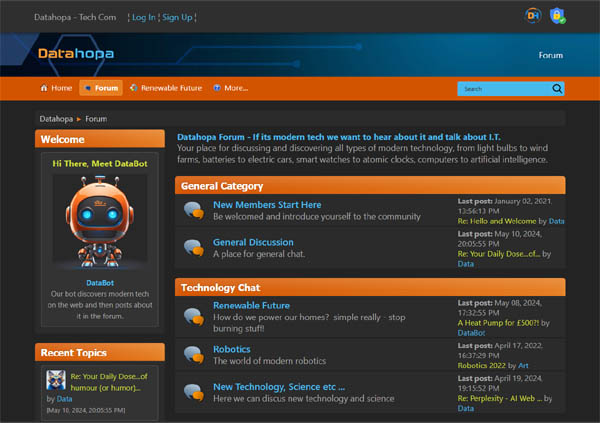
DataBot
Our bot discovers modern tech on the web and then posts about it in the forum.
-
 Green Industrial Revolution, North's...
by DataBot
Green Industrial Revolution, North's...
by DataBot
[Today at 07:41:01 AM] -
 BBC's EV Vendetta, UK Charging Bonus...
by DataBot
BBC's EV Vendetta, UK Charging Bonus...
by DataBot
[May 19, 2024, 19:37:27 PM] -
 Re: Random Music Videos
by Snowcrash
Re: Random Music Videos
by Snowcrash
[May 18, 2024, 12:23:55 PM] -
 The Rise of Perovskite Solar Panels:...
by DataBot
The Rise of Perovskite Solar Panels:...
by DataBot
[May 18, 2024, 03:02:12 AM] -
 We all start this way
by Freddy
We all start this way
by Freddy
[May 17, 2024, 15:34:57 PM] -
 THIS Is How You Power Electric Flight!...
by DataBot
THIS Is How You Power Electric Flight!...
by DataBot
[May 16, 2024, 18:51:49 PM] -
 Is The UK Ready For Heat Pumps?
by DataBot
Is The UK Ready For Heat Pumps?
by DataBot
[May 16, 2024, 00:47:30 AM] -
 Help! We *need* your Commercial Vehicle...
by DataBot
Help! We *need* your Commercial Vehicle...
by DataBot
[May 15, 2024, 18:45:20 PM] -
 Is This Rooftop Turbine the Future of...
by DataBot
Is This Rooftop Turbine the Future of...
by DataBot
[May 15, 2024, 00:52:05 AM] -
 NEW Vauxhall Frontera: The new King Of...
by DataBot
NEW Vauxhall Frontera: The new King Of...
by DataBot
[May 14, 2024, 12:36:22 PM] -
 Energy as a Service: The Key to Clean...
by DataBot
Energy as a Service: The Key to Clean...
by DataBot
[May 13, 2024, 06:27:45 AM] -
 Re: Your Daily Dose...of humour (or humor)...
by Data
Re: Your Daily Dose...of humour (or humor)...
by Data
[May 10, 2024, 20:05:55 PM] -
 The very best from BEIJING Motor Show,...
by DataBot
The very best from BEIJING Motor Show,...
by DataBot
[May 09, 2024, 17:39:28 PM] -
 Re: The AI Art thread
by Freddy
Re: The AI Art thread
by Freddy
[May 08, 2024, 23:05:01 PM] -
 A Heat Pump for £500?!
by DataBot
A Heat Pump for £500?!
by DataBot
[May 08, 2024, 17:32:55 PM] -
 How Hyundai's Ioniq 5 N Rewrote The Rules...
by DataBot
How Hyundai's Ioniq 5 N Rewrote The Rules...
by DataBot
[May 08, 2024, 05:26:27 AM] -
 The Full Beijing Motor Show Low Down...
by DataBot
The Full Beijing Motor Show Low Down...
by DataBot
[May 06, 2024, 11:05:06 AM] -
 New Geely Galaxy E8: Space Age Tech For...
by DataBot
New Geely Galaxy E8: Space Age Tech For...
by DataBot
[May 02, 2024, 22:27:07 PM] -
 Tesla Backtrack BIG Style and Other (Almost)...
by DataBot
Tesla Backtrack BIG Style and Other (Almost)...
by DataBot
[May 01, 2024, 22:22:22 PM] -
 Are Electric Lorries REALLY The Future?!...
by DataBot
Are Electric Lorries REALLY The Future?!...
by DataBot
[April 30, 2024, 22:11:03 PM]

Datahopa is advert free,
let's keep it that way.

London to Australia in 4 hours anyone?
Started by DD1975, January 02, 2012, 09:15:05 AM
Previous topic - Next topic0 Members and 1 Guest are viewing this topic. Total views: 5,771




